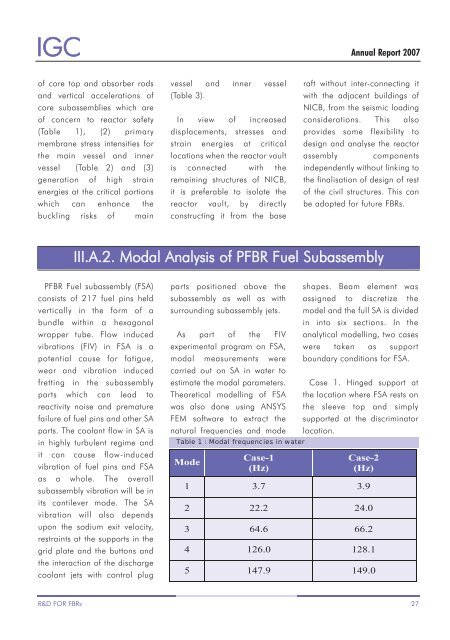IGCAR : Annual Report - Indira Gandhi Centre for Atomic Research
IGCAR : Annual Report - Indira Gandhi Centre for Atomic Research
IGCAR : Annual Report - Indira Gandhi Centre for Atomic Research
You also want an ePaper? Increase the reach of your titles
YUMPU automatically turns print PDFs into web optimized ePapers that Google loves.
IGC<br />
<strong>Annual</strong> <strong>Report</strong> 2007<br />
of core top and absorber rods<br />
and vertical accelerations of<br />
core subassemblies which are<br />
of concern to reactor safety<br />
(Table 1), (2) primary<br />
membrane stress intensities <strong>for</strong><br />
the main vessel and inner<br />
vessel (Table 2) and (3)<br />
generation of high strain<br />
energies at the critical portions<br />
which can enhance the<br />
buckling risks of main<br />
vessel and inner vessel<br />
(Table 3).<br />
In view of increased<br />
displacements, stresses and<br />
strain energies at critical<br />
locations when the reactor vault<br />
is connected with the<br />
remaining structures of NICB,<br />
it is preferable to isolate the<br />
reactor vault, by directly<br />
constructing it from the base<br />
raft without inter-connecting it<br />
with the adjacent buildings of<br />
NICB, from the seismic loading<br />
considerations. This also<br />
provides some flexibility to<br />
design and analyse the reactor<br />
assembly components<br />
independently without linking to<br />
the finalisation of design of rest<br />
of the civil structures. This can<br />
be adopted <strong>for</strong> future FBRs.<br />
III.A.2. Modal Analysis of PFBR Fuel Subassembly<br />
PFBR Fuel subassembly (FSA)<br />
consists of 217 fuel pins held<br />
vertically in the <strong>for</strong>m of a<br />
bundle within a hexagonal<br />
wrapper tube. Flow induced<br />
vibrations (FIV) in FSA is a<br />
potential cause <strong>for</strong> fatigue,<br />
wear and vibration induced<br />
fretting in the subassembly<br />
parts which can lead to<br />
reactivity noise and premature<br />
failure of fuel pins and other SA<br />
parts. The coolant flow in SA is<br />
in highly turbulent regime and<br />
it can cause flow-induced<br />
vibration of fuel pins and FSA<br />
as a whole. The overall<br />
subassembly vibration will be in<br />
its cantilever mode. The SA<br />
vibration will also depends<br />
upon the sodium exit velocity,<br />
restraints at the supports in the<br />
grid plate and the buttons and<br />
the interaction of the discharge<br />
coolant jets with control plug<br />
parts positioned above the<br />
subassembly as well as with<br />
surrounding subassembly jets.<br />
As part of the FIV<br />
experimental program on FSA,<br />
modal measurements were<br />
carried out on SA in water to<br />
estimate the modal parameters.<br />
Theoretical modelling of FSA<br />
was also done using ANSYS<br />
FEM software to extract the<br />
natural frequencies and mode<br />
Table 1 : Modal frequencies in water<br />
Mode<br />
Case-1<br />
(Hz)<br />
shapes. Beam element was<br />
assigned to discretize the<br />
model and the full SA is divided<br />
in into six sections. In the<br />
analytical modelling, two cases<br />
were taken as support<br />
boundary conditions <strong>for</strong> FSA.<br />
Case 1. Hinged support at<br />
the location where FSA rests on<br />
the sleeve top and simply<br />
supported at the discriminator<br />
location.<br />
Case-2<br />
(Hz)<br />
1 3.7 3.9<br />
2 22.2 24.0<br />
3 64.6 66.2<br />
4 126.0 128.1<br />
5 147.9 149.0<br />
R&D FOR FBRs 27

















